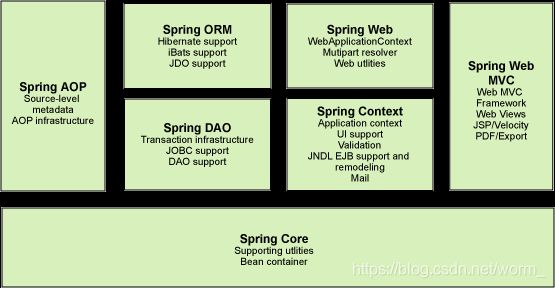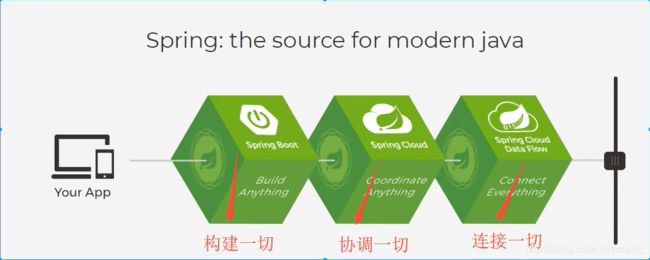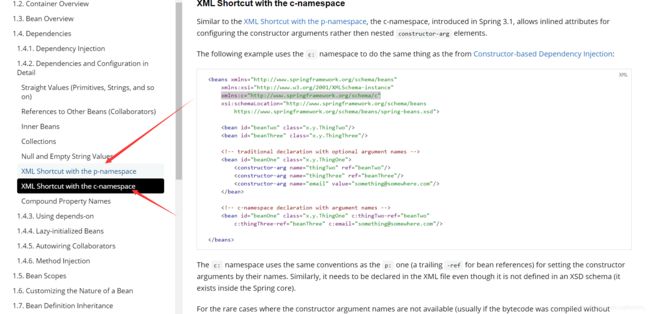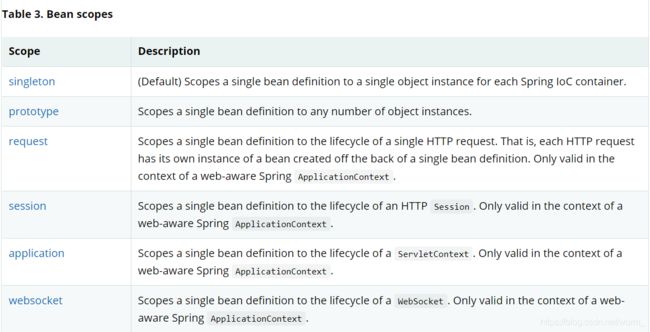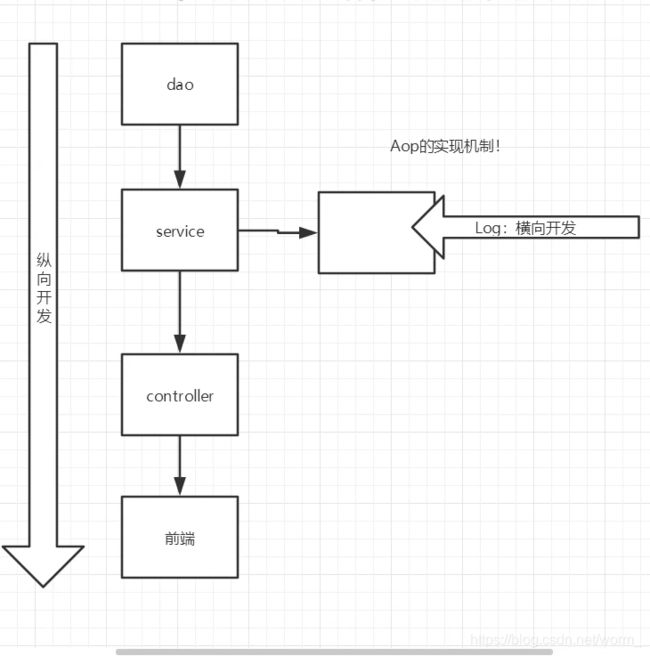Spring5 详解 B站 狂神 学习笔记
目录
- 1、 Spring
-
- 1、简介
- 2、优点
- 3、组成
- 4、拓展
- 2、IOC理论推导
-
- IOC本质
- 3、HelloSpring
-
- 思考问题?
- 4、IOC创建对象的方式
- 5、Spring配置
-
- 1、别名
- 2、Bean的配置
- 3、import
- 6、DI依赖注入
-
- 1、构造器注入
- 2、Set方式注入【重点】
- 3、拓展方式注入
- 4、bean的作用域
- 7、Bean的自动装配
-
- 1、测试
- 2、ByName自动装配
- 3、ByType自动装配
- 4、使用注解实现自动装配
- 科普:
- 8、使用注解开发
- 9、使用Java的方式配置Spring
- 10、代理模式
-
- 1、静态代理:
- 2、加深理解
- 3、动态代理
- 11、AOP
-
- 1、什么是AOP
- AOP在Spring中的作用
- 3、使用Spring实现AOP
-
- 12、整合Mybatis
- 2、Mybatis-Spring【详见狂神视频】
- 13、声明式事务
-
- 1、回顾事务
1、 Spring
1、简介
- 2002 首次推出了Spring框架的雏形:interface21框架
- Spring理念:使现有的技术更加容易使用,本身是一个大杂烩,整合了现有的技术框架
- 官网:https://spring.io/projects/spring-framework
- 官方下载地址:
- Github:https://github.com/spring-projects/spring-framework
jar包
<dependencies>
<dependency>
<groupId>org.springframeworkgroupId>
<artifactId>spring-webmvcartifactId>
<version>5.2.9.RELEASEversion>
dependency>
dependencies>
2、优点
- Spring是一个免费的框架(容器)
- Spring是一个轻量级的、非入侵式的框架
- 控制反转(IOC),面向切面编程(AOP)
- 支持事务的处理,对框架整合的支持!
总结:Spring就是一个轻量级的控制反转(IOC)和面向切面编程(AOC)的框架!
3、组成
4、拓展
-
Spring Boot
1、一个快速开发的脚手架
2、基于SpringBoot可以快速开发单个的微服务
3、约定大于配置!
-
Spring Cloud
1、SpringCloud是基于SpringBoot实现的
注:学习SpringBoot的前提需要完全掌握Spring及SpringMVC!
弊端:发展了太久,违背了原来的理念!配置十分繁琐,人称“配置地狱!”
2、IOC理论推导
- User接口
- UserImpl实现类
- UserService业务接口
- UserServiceImpl业务实现类
在我们之前的也业务中,用户的需求可能会影响我们的代码,我们需要根据用户的需求去修改代码,如果程序的代码量十分大,修改一次的成本代价十分昂贵!
我们使用一个set接口实现,代码已经发生了革命性的变化!
public class UserServiceImpl implements UserService {
private User user;
//利用set进行松台实现值的注入
public void setUser(User user) {
this.user = user;
}
- 之前,程序是主动创建对象,控制权在程序猿手上!
- 使用了set注入之后,程序不再具有主动性,而是变成了被动的接受对象
这种思想,从本质上解决了问题,我们程序猿不用再去管理对象的创建了。系统的耦合性大大降低,可以更加专注的在业务的实现上!这就是IOC的原型!
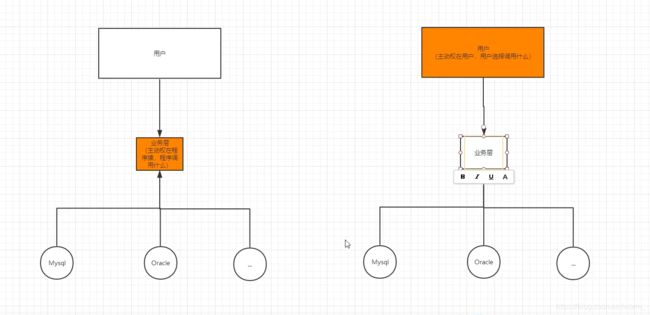
IOC本质
控制反转IoC(Inversion of Control),是一种设计思想,DI(依赖注入)是实现IoC的一种方法,也有人认为DI只是IoC的另一种说法。没有IoC的程序中 , 我们使用面向对象编程 , 对象的创建与对象间的依赖关系完全硬编码在程序中,对象的创建由程序自己控制,控制反转后将对象的创建转移给第三方,个人认为所谓控制反转就是:获得依赖对象的方式反转了。
采用XML方式配置Bean的时候,Bean的定义信息是和实现分离的,而采用注解的方式可以把两者合为一体,Bean的定义信息直接以注解的形式定义在实现类中,从而达到了零配置的目的。
控制反转是一种通过描述(XML或注解)并通过第三方去生产或获取特定对象的方式。在Spring中实现控制反转的是IoC容器,其实现方法是依赖注入(Dependency Injection,DI)。
3、HelloSpring
实体类的set注入方法
public class Hello {
private String str;
public String getStr() {
return str;
}
public void setStr(String str) {
this.str = str;
}
将实体类注册到配置文件中
<bean id="hello" class="com.kuang.pojo.Hello">
<property name="str" value="核力量"/>
bean>
测试
public static void main(String[] args) {
//获取Spring的上下文对象!
ClassPathXmlApplicationContext context = new ClassPathXmlApplicationContext("beans.xml");
//我们的对象都在Spring中管理了,我们要使用,直接去里面取出来就可以!
Hello hello = (Hello)context.getBean("hello");
System.out.println(hello.toString());
}
思考问题?
- Hello对象是谁创建的?
hello对象是由Spring创建的 - Hello对象的属性是怎么设置的?
hello对象的属性是由Spring容器设置的
这个过程就叫控制反转
- 控制:传统应用程序的对象是由程序本身创建的,使用Spring后,对象是由Spring来创建的
- 反转:程序本身不创建对象,而变成被动的接受对象
- 依赖注入:就是利用set方法来进行注入的
- IOC是一种编程思想,由主动的编程变成被动的接受
- 可以通过new ClassPathXmlApplicationContext 浏览一下底层源码
OK,到了现在,我们彻底不用在程序中去改动了,要实现不同的操纵,只需要在xml配置中进行修改,所谓的IOC,一句话搞定:对象由Spring来创建,管理,装配!
4、IOC创建对象的方式
- 使用无参构造创建对象,默认!
- 使用有参构造创建对象
参数下标赋值
<bean id="user" class="com.kuang.pojo.User">
<constructor-arg index="0" value="昂给"/>
bean>
参数类型赋值
<bean id="user" class="com.kuang.pojo.User">
<constructor-arg type="java.lang.String" value="回家看了"/>
bean>
参数名赋值
<bean id="user" class="com.kuang.pojo.User">
<constructor-arg name="name" value="后i"/>
bean>
总结:在配置文件加载的时候,容器中管理的对象就已经被初始化了!
5、Spring配置
1、别名
<alias name="user" alias="user2"/>
2、Bean的配置
<bean id="user" class="com.kuang.pojo.User" name="user2;u2,u3 u4">
<constructor-arg name="name" value="后i"/>
bean>
3、import
import一般用于团队开发使用,可以将多个配置文件导入applicationContext.xml合并为一个
<import resource="beans.xml"/>
<import resource="beans1.xml"/>
<import resource="beans2.xml"/>
6、DI依赖注入
1、构造器注入
依赖注入:Set注入!
依赖:bean对象的创建依赖于容器
注入:bean对象中的所有属性
2、Set方式注入【重点】
【环境搭建】
- 复杂类型
public class Address {
private String address;
public String getAddress() {
return address;
}
public void setAddress(String address) {
this.address = address;
}
}
- 真实测试对象
public class Student {
private String name;
private String wife;
private Address address;
private String[] books;
private List<String> hobbys;
private Map<String,String> card;
private Set<String> games;
private Properties info;
- applicationContext.xml
<beans xmlns="http://www.springframework.org/schema/beans"
xmlns:xsi="http://www.w3.org/2001/XMLSchema-instance"
xsi:schemaLocation="http://www.springframework.org/schema/beans
http://www.springframework.org/schema/beans/spring-beans.xsd">
<bean id="address" class="com.kuang.pojo.Address"/>
<bean id="student" class="com.kuang.pojo.Student">
<property name="name" value="狠人大帝"/>
<property name="address" ref="address"/>
<property name="books">
<array>
<value>西游记value>
<value>三国演义value>
<value>红楼梦value>
<value>水浒传value>
array>
property>
<property name="hobbys">
<list>
<value>听歌value>
<value>敲代码value>
<value>看电影value>
list>
property>
<property name="card">
<map>
<entry key="耳根" value="《仙逆》"/>
<entry key="辰东" value="《完美世界》"/>
<entry key="猫腻" value="《大道朝天》"/>
map>
property>
<property name="games">
<set>
<value>植物大战僵尸value>
<value>城市天际线value>
<value>保卫萝卜value>
set>
property>
<property name="wife" >
<null/>
property>
<property name="info">
<props>
<prop key="driver">4567645674prop>
<prop key="id">4567645674prop>
<prop key="pwd">4567645674prop>
props>
property>
bean>
beans>
4.测试类
public class MyTest {
public static void main(String[] args) {
ClassPathXmlApplicationContext context = new ClassPathXmlApplicationContext("applicationContext.xml");
Student student = (Student) context.getBean("student");
System.out.println(student.getAddress());
}
}
3、拓展方式注入
<beans xmlns="http://www.springframework.org/schema/beans"
xmlns:xsi="http://www.w3.org/2001/XMLSchema-instance"
xmlns:p="http://www.springframework.org/schema/p"
xmlns:c="http://www.springframework.org/schema/c"
xsi:schemaLocation="http://www.springframework.org/schema/beans
http://www.springframework.org/schema/beans/spring-beans.xsd">
<bean id="user" class="com.kuang.pojo.User" p:age="18" p:name="哈克"/>
<bean id="user2" class="com.kuang.pojo.User" c:age="18" c:name="哈g克"/>
beans>
注意:p命名空间和c命名空间不能直接使用,需要导入xml约束
xmlns:p="http://www.springframework.org/schema/p"
xmlns:c="http://www.springframework.org/schema/c"
4、bean的作用域
- 单例模式(Spring默认机制)
<bean id="user2" class="com.kuang.pojo.User" c:age="18" c:name="哈g克" scope="singleton"/>
- 原型模式:每次从容器中get的时候,都会产生一个新对象!
<bean id="user2" class="com.kuang.pojo.User" c:age="18" c:name="哈g克" scope="prototype"/>
- 其余的request、session、application 、这些个只能在web开发中使用到!
7、Bean的自动装配
- 自动装配是Spring满足bean依赖注入的一种方式!
- Spring会在上下文中自动寻找,并自动给bean装配属性!
在Spring中有三种装配方式
- 在xml中显示的配置
- 在java中显示配置
- 隐式的自动装配bean【重要】
1、测试
环境搭建:一个人有两个宠物
2、ByName自动装配
<bean id="cat" class="com.kuang.pojo.Cat"/>
<bean id="dog" class="com.kuang.pojo.Dog"/>
<bean id="people" class="com.kuang.pojo.People" autowire="byName">
<property name="name" value="杨戬"/>
bean>
3、ByType自动装配
<bean id="cat" class="com.kuang.pojo.Cat"/>
<bean id="dog222" class="com.kuang.pojo.Dog"/>
<bean id="people" class="com.kuang.pojo.People" autowire="byType">
<property name="name" value="杨戬"/>
bean>
小结:
- ByName的时候,需要保证所有bean的id唯一,并且这个bean需要和自动注入的属性set方法的值一致
- ByName的时候,需要保证所有bean的class唯一,并且这个bean需要和自动注入的属性的类型一致
4、使用注解实现自动装配
jdk1.5支持的注解,Spring2.5就支持注解了
要使用注解须知:
- 导入约束,context约束
- 配置注解的支持: context:annotation-config/
<beans xmlns="http://www.springframework.org/schema/beans"
xmlns:xsi="http://www.w3.org/2001/XMLSchema-instance"
xmlns:context="http://www.springframework.org/schema/context"
xmlns:aop="http://www.springframework.org/schema/aop"
xsi:schemaLocation="http://www.springframework.org/schema/beans
https://www.springframework.org/schema/beans/spring-beans.xsd
http://www.springframework.org/schema/context
https://www.springframework.org/schema/context/spring-context.xsd
http://www.springframework.org/schema/aop
https://www.springframework.org/schema/aop/spring-aop.xsd">
<context:annotation-config/>
beans>
- AutoWired
直接在属性上使用即可,也可以在set方法上使用!
使用Autowired我们可以不用编写Set方法了,前提是你这个自动装配的属性在IOC(Spring)容器中存在,且符合名字ByName!
public class People {
private String name;
@Autowired
private Cat cat;
@Autowired
private Dog dog;
科普:
@Nullable 字段标记了这个注解,说明这个字段可以为null。
@Autowired:
public @interface Autowired {
boolean required() default true;
}
测试代码
ublic class People {
private String name;
//如果显示定义了Autowired的required属性为false,说明这个对象可以为null,否则不允许为空
@Autowired(required = false)
private Cat cat;
@Autowired
private Dog dog;
如果@Autowired自动装配环境比较复杂,自动装配无法通过一个注解【@Autowired】确定唯一完成的时候,我们可以使用@Quailefier(value=“xxx”)去配合具体限定唯一的bean对象注入!
<bean id="dog" class="com.kuang.pojo.Dog"/>
<bean id="dog22" class="com.kuang.pojo.Dog"/>
public class People {
private String name;
//如果显示定义了Autowired的required属性为false,说明这个对象可以为null,否则不允许为空
@Autowired
private Cat cat;
@Autowired
@Qualifier(value = "dog22")
private Dog dog;
@Resource注解:jdk类库中提供的注解
@Resource(name = "cat2")
private Cat cat;
<bean id="cat1" class="com.kuang.pojo.Cat"/>
<bean id="cat2" class="com.kuang.pojo.Cat"/>
小结:
@Autowired注解和@Resource注解的区别
- 都是用来自动装配的,都可以放在属性字段上
- @Autowired通过byType的方式实现,而且必须要求这个对象存在【常用】
- @Autowired先是根据类型注入,找出来不止一个的话会根据名字注入
- @resource默认通过byType的方式实现,有多个再根据名字注入!两个都找不到,就报错!【常用】
8、使用注解开发
再Spring4之后,要使用注解开发,必须保证aop的包导入
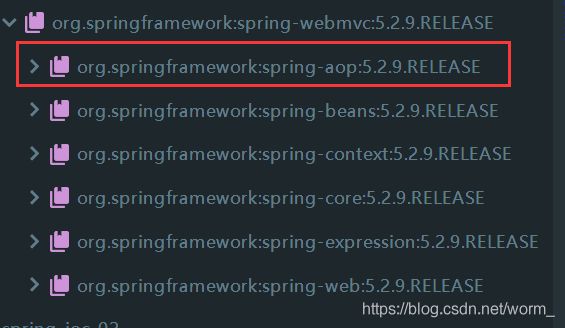
使用注解需要导入context约束,增加注解的支持!
- bean
- 属性如何注入
@Component
public class User {
@Value("青山归井九")
public String name;
}
-
衍生的注解
@Component有几个衍生的注解,我在web开发中,会按照MVC三层架构分层!dao【@Repository】
service【@Service】
controller【@Controller】
这四个注解功能都是一样的,都是代表将某个类注册到Spring中,装配Bean
- 自动装配置
@Autowired:自动装配通过类型,名字
如果@Autowired不能唯一自动装配上属性,则需要通过@Qualifier(value = "xxx")
@Nullable:字段标记了这个注解,说明这个字段可以为null
@resource:自动装配,通过名字,类型。
- 作用域
@Component
@Scope("prototype")
public class User {
@Value("青山归井九")
public String name;
}
-
小结:
xml与注解:xml更加万能,适用于任何场合!维护简单方便
注解不是自己的类使用不了,维护相对复杂
xml与注解的最佳实践:
xml用来管理bean
注解只负责完成属性的注入
9、使用Java的方式配置Spring
我们现在要完全不使用Sprig的xml配置了,全权交给java来做!
JavaConfig是Spring的一个子项目,在Spring4之后,他成为了一个核心功能
package com.kuang.pojo;
import org.springframework.beans.factory.annotation.Value;
import org.springframework.stereotype.Component;
import org.springframework.stereotype.Controller;
//这个注解的意思是,就是说明这个类被Spring接管了,注册人到了容器中
@Component
public class User {
@Value("hi哦")
private String name;
public String getName() {
return name;
}
public void setName(String name) {
this.name = name;
}
@Override
public String toString() {
return "User{" +
"name='" + name + '\'' +
'}';
}
}
配置文件
@Configuration//这个也会被Spring容器托管,注册到容器中,因为他本来就是一个@Component
@ComponentScan("com.kuang.pojo")
@Import(KuangConfig2.class)
public class KuangConfig {
@Bean
public User getUser(){
return new User();
}
}
测试类
import com.kuang.pojo.User;
import com.kuang.pojo.config.KuangConfig;
import org.springframework.context.ApplicationContext;
import org.springframework.context.annotation.AnnotationConfigApplicationContext;
public class MyTest {
public static void main(String[] args) {
//如果完全使用了配置类的方式去做,我们就只能通过AnnotationConfig上下文来获取容器,通过配置类的class对象加载!
ApplicationContext context = new AnnotationConfigApplicationContext(KuangConfig.class);
User getUser = (User) context.getBean("getUser");
System.out.println(getUser.getName());
}
}
这种纯java的配置方式,在SpringBoot中随处可见
10、代理模式
为什么要学习代理模式?因为这就是SpringAOP的底层!
代理模式的分类:
- 静态代理
- 动态代理
1、静态代理:
角色分析
- 抽象角色:一般会使用接口或者抽象类来解决
- 真实角色: 被代理的角色
- 代理角色:代理真实角色,代理真实角色后,我们一般会做一些附属操作
- 客户:访问代对象的人
代码步骤
- 接口
package com.kuang.demo01;
public interface Rent {
public void rent();
}
- 真实角色
package com.kuang.demo01;
//房东
public class LandLord implements Rent{
@Override
public void rent() {
System.out.println("房东要出租房子了");
}
}
- 代理角色
package com.kuang.demo01;
public class Proxy implements Rent{
private LandLord host;
public Proxy() {
}
public Proxy(LandLord host) {
this.host = host;
}
@Override
public void rent() {
seeHouse();
feeHouse();
host.rent();
contract();
}
//看房
public void seeHouse(){
System.out.println("中介带你看房");
}
//看房
public void feeHouse(){
System.out.println("中介收费");
}
//看房
public void contract(){
System.out.println("中介和你签合同");
}
}
- 客户端访问代理角色
package com.kuang.demo01;
public class Client {
public static void main(String[] args) {
//房东要租房子
LandLord host = new LandLord();
//代理,中介,有附加操作
Proxy proxy = new Proxy(host);
//找中介租房
proxy.rent();
}
}
代理模式的好处
- 可以使真实角色的操作更加纯粹,不用去关注一些公共业务
- 公共业务就交给代理就角色,实现了业务的分工
- 公共业务发生拓展的时候,方便集中管理
缺点
- 要给真实角色就会产生一个代理角色,代码量会翻倍,开发效率降低
2、加深理解
3、动态代理
- 动态代理和静态代理角色一样
- 动态代理的代理类是动态生成的,不是我们直接写好的
- 动态代理分为两大类:基于接口的动态代理,基于类的动态代理
1. 基于接口----JDK动态代理
2. 基于类----cglib
3. Java字节码实现
需要了解两个类:Proxy:动态生成代理类的静态方法,InvocationHandler:调用处理程序(实现方法),并返回一个结果
动态代理的好处:
- 可以使真实角色的操作更加纯粹,不用去关注一些公共业务
- 公共业务就交给代理就角色,实现了业务的分工
- 公共业务发生拓展的时候,方便集中管理
- 一个动态代理类代理的是一个接口,一般就是对应的一类业务
- 一个动态代理类可以代理多个类,只要实现了同一个接口即可
要代理的接口
package com.kuang.demo01;
public interface Rent {
public void rent2();
}
实现接口的类
package com.kuang.demo01;
//房东
public class LandLord implements Rent{
@Override
public void rent2() {
System.out.println("房东要出租房子了");
}
public void rent3(){
System.out.println("房东出大房子");
}
}
代理类
package com.kuang.demo01;
import java.lang.reflect.InvocationHandler;
import java.lang.reflect.Method;
import java.lang.reflect.Proxy;
//用这个类,自动生成代理类
public class ProxyInvocatinHandler implements InvocationHandler {
//被代理的接口
private Object target;
public void setTarget(Object target) {
this.target = target;
}
//生成得到代理类
public Object getProxy(){
return Proxy.newProxyInstance(this.getClass().getClassLoader(),target.getClass().getInterfaces(),this);
}
@Override
//处理代理实例,并返回结果
public Object invoke(Object proxy, Method method, Object[] args) throws Throwable {
log(method.getName());
Object result = method.invoke(target, args);
return result;
}
public void log(String msg){
System.out.println("执行了"+msg+"方法");
}
}
用户通过代理类租房
public static void main(String[] args) {
//真实角色
LandLord host = new LandLord();
//代理角色
ProxyInvocatinHandler handler = new ProxyInvocatinHandler();
//设置要代理的对象
handler.setTarget(host);
//动态生成代理类
Rent proxy = (Rent) handler.getProxy();
//找中介租房
proxy.rent2();
}
}
11、AOP
1、什么是AOP
在软件业,AOP为Aspect Oriented Programming的缩写,意为:面向切面编程,通过预编译方式和运行期间动态代理实现程序功能的统一维护的一种技术。AOP是OOP的延续,是软件开发中的一个热点,也是Spring框架中的一个重要内容,是函数式编程的一种衍生范型。利用AOP可以对业务逻辑的各个部分进行隔离,从而使得业务逻辑各部分之间的耦合度降低,提高程序的可重用性,同时提高了开发的效率。
AOP在Spring中的作用
提供声明式服务;允许用户自定义切面
横切关注点:跨越应用程序多个模块的方法或功能.既是,与我们业务逻辑无关,但是我们需要关注的部分,就是横切关注点.如日志,安全,缓存,事务等…
-
切面(ASPECT):横切关注点 被模块化 的特殊对象。即,它是一个类。
-
通知(Advice):切面必须要完成的工作。即,它是类中的一个方法。
-
目标(Target):被通知对象。
-
代理(Proxy):向目标对象应用通知之后创建的对象。
-
切入点(PointCut):切面通知 执行的 “地点”的定义。
-
连接点(JointPoint):与切入点匹配的执行点。
SpringAOP中,通过Advice定义横切逻辑,Spring中支持5中类型的Advice
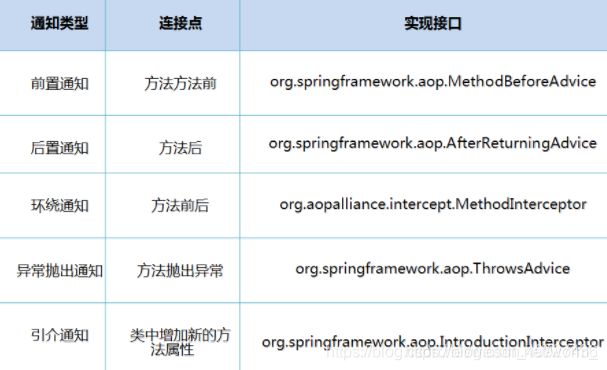
即AOP在不改变原有代码的情况下,去增加新的功能
3、使用Spring实现AOP
使用AOP织入,需要导入一个依赖包!
<dependency>
<groupId>org.aspectjgroupId>
<artifactId>aspectjweaverartifactId>
<version>1.9.4version>
dependency>
方式一:使用Spring的API接口
切入点前切入的类
package com.kuang.log;
import org.springframework.aop.MethodBeforeAdvice;
import java.lang.reflect.Method;
public class Log implements MethodBeforeAdvice {
//method:要执行的目标对象方法
//args:参数
//target:目标对象
@Override
public void before(Method method, Object[] args, Object target) throws Throwable {
System.out.println(target.getClass().getName()+"的"+method.getName()+"被执行了");
}
}
切入点后切入的类
package com.kuang.log;
import org.springframework.aop.AfterReturningAdvice;
import java.lang.reflect.Method;
public class AfterLog implements AfterReturningAdvice {
//returnValue:返回值
@Override
public void afterReturning(Object returnValue, Method method, Object[] args, Object target) throws Throwable {
System.out.println("执行了"+method.getName()+"返回了"+returnValue);
}
}
applicationContext.xml
<beans xmlns="http://www.springframework.org/schema/beans"
xmlns:xsi="http://www.w3.org/2001/XMLSchema-instance"
xmlns:aop="http://www.springframework.org/schema/aop"
xsi:schemaLocation="http://www.springframework.org/schema/beans
http://www.springframework.org/schema/beans/spring-beans.xsd
http://www.springframework.org/schema/aop
http://www.springframework.org/schema/aop/spring-aop.xsd">
<bean id="afterLog" class="com.kuang.log.AfterLog"/>
<bean id="log" class="com.kuang.log.Log"/>
<aop:config>
<aop:pointcut id="pointcut" expression="execution(* com.kuang.service.UserServiceImpl.*(..))"/>
<aop:advisor advice-ref="log" pointcut-ref="pointcut"/>
<aop:advisor advice-ref="afterLog" pointcut-ref="pointcut"/>
aop:config>
beans>
测试:
public class MyTest {
public static void main(String[] args) {
ClassPathXmlApplicationContext context = new ClassPathXmlApplicationContext("applicationContext.xml");
//动态代理的是接口
UserService userService = (UserService) context.getBean("userServiceImpl");
userService.add();
}
}
方式二:自定义类
package com.kuang.diy;
public class diyLog {
public void before(){
System.out.println("前");
}
public void after(){
System.out.println("后");
}
}
applicationContext.xml
<bean id="diy" class="com.kuang.diy.diyLog"/>
<aop:config>
<aop:aspect ref="diy">
<aop:pointcut id="point" expression="execution(* com.kuang.service.UserServiceImpl.*(..))"/>
<aop:before method="before" pointcut-ref="point"/>
<aop:after method="after" pointcut-ref="point"/>
aop:aspect>
aop:config>
方式三:注解实现
自定义类
package com.kuang.diy;
import org.aspectj.lang.annotation.After;
import org.aspectj.lang.annotation.Aspect;
import org.aspectj.lang.annotation.Before;
//使用注解方式实现AOP
@Aspect//标注这个类是个切面
public class AnnotationPointCut {
@Before("execution(* com.kuang.service.UserServiceImpl.*(..))")
public void befor(){
System.out.println("qian");
}
@After("execution(* com.kuang.service.UserServiceImpl.*(..))")
public void after(){
System.out.println("hou");
}
}
applicationContext
<bean id="annoPoint" class="com.kuang.diy.AnnotationPointCut"/>
<aop:aspectj-autoproxy/>
12、整合Mybatis
1、导入相关jar包
- junit
- mybatis
- mysql数据库
- spring相关的
- aop织入
- mybatis-spring
<dependencies>
<dependency>
<groupId>junitgroupId>
<artifactId>junitartifactId>
<version>4.12version>
dependency>
<dependency>
<groupId>mysqlgroupId>
<artifactId>mysql-connector-javaartifactId>
<version>8.0.22version>
dependency>
<dependency>
<groupId>org.mybatisgroupId>
<artifactId>mybatisartifactId>
<version>3.5.2version>
dependency>
<dependency>
<groupId>org.springframeworkgroupId>
<artifactId>spring-webmvcartifactId>
<version>5.1.9.RELEASEversion>
dependency>
<dependency>
<groupId>org.springframeworkgroupId>
<artifactId>spring-jdbcartifactId>
<version>5.3.3version>
dependency>
<dependency>
<groupId>org.aspectjgroupId>
<artifactId>aspectjweaverartifactId>
<version>1.9.4version>
dependency>
<dependency>
<groupId>org.mybatisgroupId>
<artifactId>mybatis-springartifactId>
<version>2.0.5version>
dependency>
dependencies>
2、编写配置文件
3、测试
2、Mybatis-Spring【详见狂神视频】
- 编写数据源配置
- sqlSessionfatroy
- sqlSessionTemplate
- 需要给接口加实现类【】
- 将自己写的实现类注入到Spring中测试使用
13、声明式事务
1、回顾事务
- 把一组业务当成一个业务来做 要么都成功,要么都失败!
- 事务项目的开发中,十分的重要,涉及到数据一致性的问题,不能马虎
- 确保完整性和一致性
事务ACID原则
- 原子性
- 一致性
- 隔离性:多个业务可能操作同一个资源,防止数据损坏
- 持久性:事务一旦提交,无论系统发生什么问题吗,结果都不会被影响,被持久化的写到存储器中
